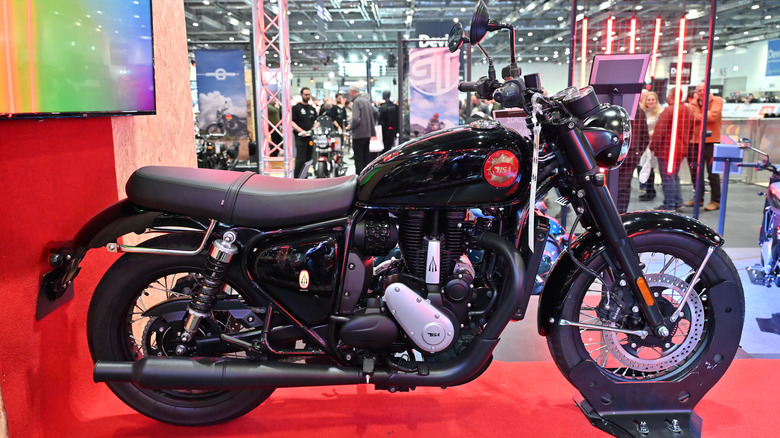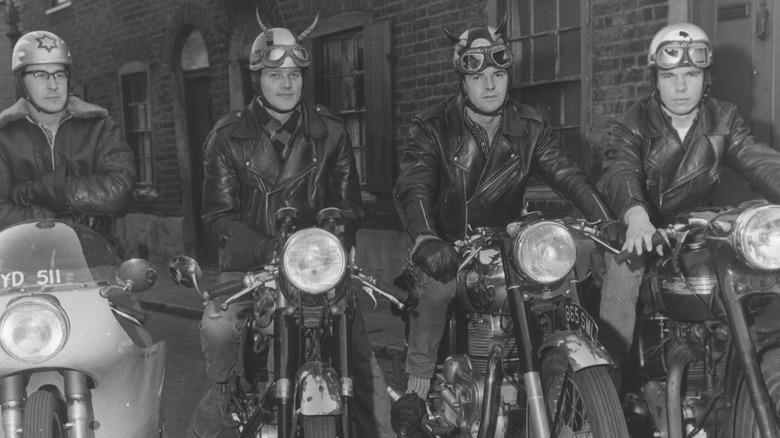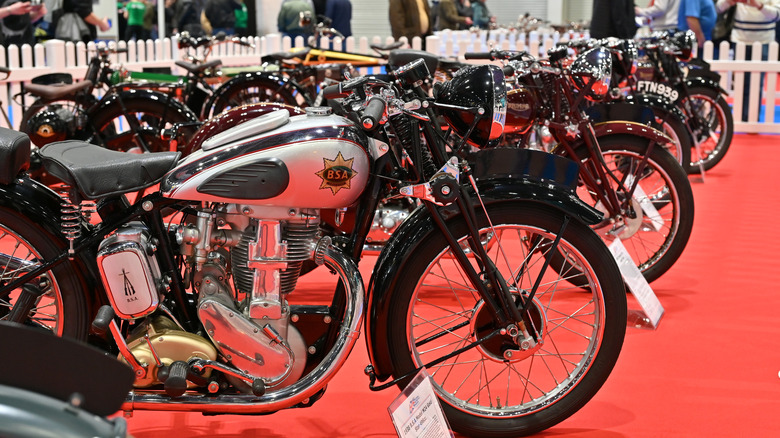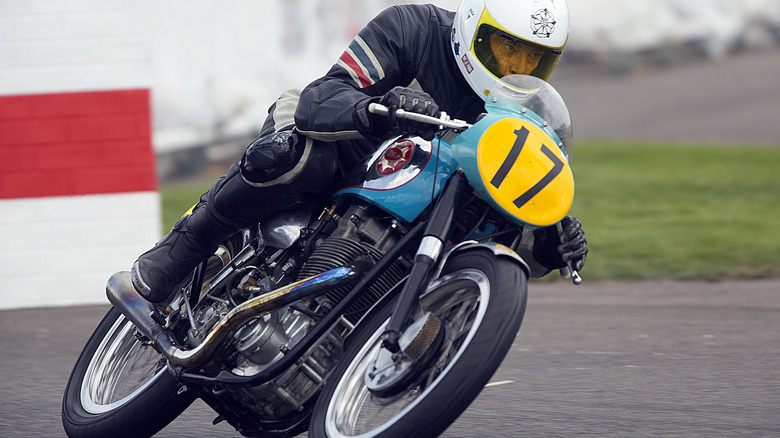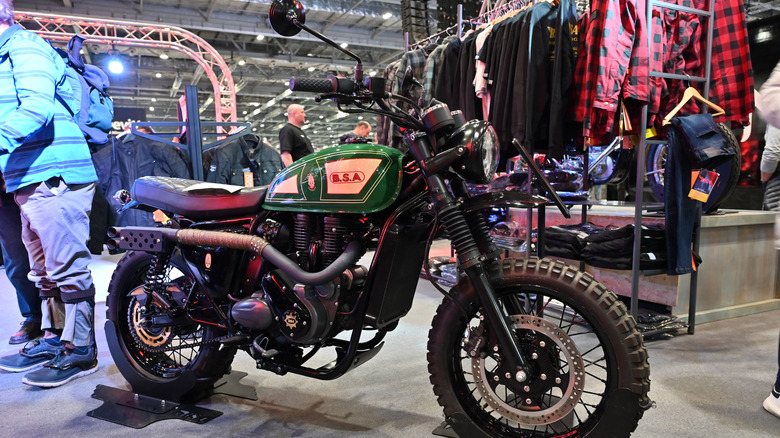Everything To Know About The BSA Gold Star Motorcycle
The 1930s was a fascinating and transformative time for the automobile industry. A certain Henry Ford had changed the game forever in 1913, with his assembly line that had advanced his dream of creating, quotes History, "motor car[s] for the great multitude." Almost three decades later, cars and motorcycles were appearing around the world in unprecedented numbers, some select models of which are still admired today. In the two-wheeled arena, the venerable BSA Gold Star, just one of the company's classic models, is one high-profile example.
Needless to say, a lot of auto models from almost a century ago are long since discontinued, perhaps only occasionally seeing the light of day in vintage car collectors' garages or in museums. The Gold Star, however, managed something very special: It outlived the original company that developed it, being relaunched decades later with specs worthy of a contemporary model.
The motorcycle's very name speaks of attainment, so let's investigate that fascinating legacy. Here's a look at the origins of the BSA Gold Star, how the model's specs have evolved over its long life, the differences introduced by variants that have hit the market, and exactly how that relaunch came about.
The original BSA Gold Star gets its name
The Gold Star's beginnings are closely tied to the career of another star: Wal Handley, a British motorcycle racer. Handley had been working with motorcycles from an early age, joining Humphries & Dawes in 1921 in his late teens. By 1937, Handley's racing prowess was so well-regarded that he was selected for a high-profile race on a unique steed: the Brooklands contest atop a BSA Empire Star topping out at 33bhp. It was a formidable machine for its time, and in Handley's capable hands, it reached 107.57 mph on one lap.
In "Cafe Racers: Speed, Style, and Ton-Up Culture," Michael Lichter and Paul d'Orleans explain the true importance of this achievement in this context. With an average lap speed of over 100 mph, the performance was worth "an actual gold star for its rider, a small star pin with enameled '100.'" A simple pin it may have been on the surface, but this prize seemed to become a symbol of the pace of BSA's motorcycles. The following year, the M24 Gold Star was released, named for that very same gold star.
The model, deemed by Lichter and d'Orleans to be "essentially a Brooklands Replica with lights," was quite a powerhouse, as would be expected.
The specifications of the 1938 Gold Star
The original Gold Star, then, was born from the particularly pacey performances of Wal Handley. BSA, of course, used this angle in advertising the model, with one 1938 catalog (via Mortons Archive) sharing the origins of the model and claiming that the Gold Star would "make a special appeal to riders who want an outstandingly fast sporting machine." That speed would top out at approximately 90 mph, powered by a 496cc engine.
Sluggish it was not, but nor was its performance stellar compared to its contemporaries. Triumph's Speed Twin, which launched the very same year, featured a 500cc engine and a speed above 100 mph. As such, both the Gold Star and Speed Twin were important releases in the motorcycle arena in the troubled pre-World War II world.
With the former model, there was ample room for improvement, innovation, and legacy building as the decades went on. The Gold Star would appear in a many variations, with a lot of retro appeal, some considerably building on what came before.
Early variations on the BSA Gold Star and early victories
It would be more than a decade after its initial introduction that a new variant of the Gold Star would be added to the range. In 1949, when the planet was safely out of the horrors of World War II and was looking optimistically towards a brighter and more peaceful future, motorcyclists had a new Gold Star to consider. This was the ZB32 Gold Star, a model that implemented new alloy elements and a 350cc output. Seemingly keen to make up for lost time, BSA then launched the ZB34 in 1950, and this version took the leap up to 500cc.
These models began to define the Gold Star as a formidable clubman's racer. The key to its regard in that area wasn't its stock specifications, but its hand-built versatility. Models were available that suited road and racing needs, and a degree of freedom to select from specific parts proved to be a huge boon for riders. It was a boon that quickly bore fruit in the competitive world: By 1951, Gold Stars had achieved a successive three wins in the Junior Clubman's TT, and would go on to enjoy victories in the Catalina Grand Prix and other contests in the United States during this period and beyond.
It was clear that the Gold Star was a racing machine to be reckoned with, but there was much more to be coaxed from it yet.
The Gold Star family grows (and is reborn)
Atop a scrambler 1956 Gold Star, U.S. racer Chuck Minert triumphed in that year's Catalina Grand Prix. In doing so, he further demonstrated the great versatility of the Gold Star family. Motocross Action magazine quotes Minert as explaining that he opted for "a front brake backing plate with a scoop for additional cooling and ran a 19-inch front wheel instead of the standard 21-inch wheel preferred by the English riders." The 1959 Catalina Scrambler, another potent 500cc model, was created in honor of Minert's victory. Manufacture of this model, and of the Gold Star itself, originally ceased in 1963.
In 1971, the brand's B50SS, a 499cc model capable of 80 mph, controversially bore the Gold Star name. It would have been rather sad if it had been the last bike to do so, and it looked as though that may have been the case when BSA shut down in 1973. However, a new era for the Gold Star began in 2021, when today's brand-owners Mahindra Group and Classic Legends confirmed that a new Gold Star was being released. The model, first available in the UK in 2022, packs Phantom Sportscomp Pirelli tires, 45 hp matched with 55Nm of torque, and a 652cc engine. Perhaps, given time, it will establish itself as a racing machine worthy of its lofty name. After all, Britain has brought the world some fascinating motorcycles (just ask Steve McQueen), and the Gold Star is among the most acclaimed.
